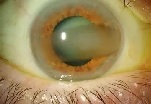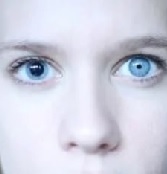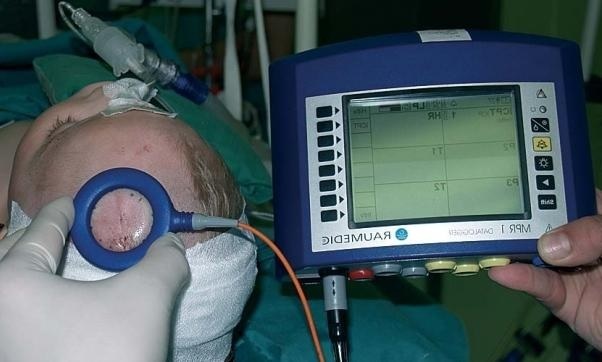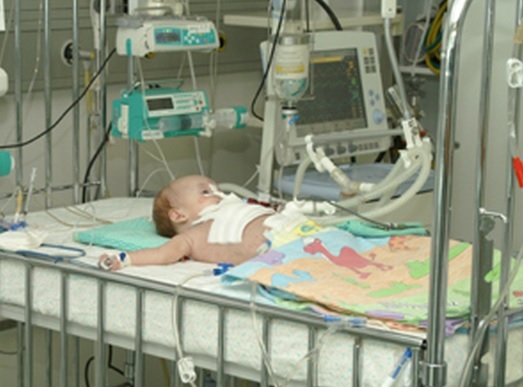Why the pupil dilates in the pupil
Contents:
- Causes of dilated pupils
- Stress
- Shock
- Craniocerebral trauma, neoplasm, abscess, epilepsy
- Eye injury
- Poisoning
- Medications
- Diagnosis
- Conclusion
 The dilated pupils in the child are not worried about their parents. This sign indicates both the psychological state of the child, and the poisoning of dangerous substances, injuries. Expansion of the pupils( as in the photo) doctors call mydriasis.
The dilated pupils in the child are not worried about their parents. This sign indicates both the psychological state of the child, and the poisoning of dangerous substances, injuries. Expansion of the pupils( as in the photo) doctors call mydriasis.
Causes of dilated pupils
The pupil is a slot through which light passes. Regulation of its diameter occurs automatically with the help of the autonomic nervous system, more precisely, the sympathetic and parasympathetic fibers of the third pair of cranial nerves.
The oculomotor nerve has centers in the brain that control the size of the pupils in accordance with the level of illumination. If the room is dark, the pupils will expand, so that more light passes through them. In conditions where there is a lot of light, they naturally contract.
Why does the child have dilated pupils? Their diameter varies with stress or pain. Pupils increase, as the influence of the sympathetic nervous system increases. However, sometimes there can be disruptions in regulation under the influence of narcotic substances, drugs, physical injuries, and heavy conditions.
 It is useful to know why there are white spots in the eyes: causes, diagnostics.
It is useful to know why there are white spots in the eyes: causes, diagnostics.
What to do when there is a fog in the eyes and head.
The main causes of dilated pupils in a child:
- Psychological stress: anxiety, fear.
- Shock state with severe pain, heavy blood loss.
- Coma.
- Craniocerebral injuries, tumors, epileptogenic foci, increased intracranial pressure.
- Eye trauma, including after surgical intervention.
- Infections of the brain with syphilis, tuberculosis, meningitis, encephalitis.
- Intoxication, including drugs, the use of drops to examine the fundus.
- Narcotic, alcoholic intoxication.
- Multiple sclerosis and other diseases of the peripheral nervous system.
- Endocrine disorders: diabetes, problems with the adrenal glands. Pheochromocytoma is a tumor of the adrenal glands secreting adrenaline. Other symptoms, other than the mydriatic effect, may be a trembling, an increase in heart rate.
- Vegeto-vascular dystonia.
- Glaucoma.
Stress
If pupils are dilated in the child, the causes may be emotional stress. They are provoked by disorders in the family, unrest in the school, medical procedures. Usually, after eliminating the irritating factor and calming the pupils of the eyes come back to normal.
Shock
May provoke mydriasis with traumatic, hypovolemic, anaphylactic( allergic) shock. With severe pain, a decrease in the volume of circulating blood, a loss of blood, the sympathetic adrenal system of the organism is activated. This is done so that vital organs and systems( the brain, the heart) receive blood in conditions of its deficiency.
Hormones cortisol, adrenaline, narrowing vessels, centralizing the blood flow, increase cardiac output. They cause mydriasis in a child. A coma may also be accompanied by this symptom, as well as a lack of reaction to light. Such a condition, as a rule, is accompanied by loss of consciousness and requires timely application for medical care.
Craniocerebral trauma, neoplasm, abscess, epilepsy
Head injury can cause large pupils in the child. Their unequal size, the absence of a friendly reaction to light in the event of the defeat of one of the nuclei of the oculomotor nerves is possible. Extended pupils in a newborn can be signs of birth trauma, intrauterine and hypoxia in the postpartum period.
 Often the cause of mydriasis is the presence in the brain of infections, epileptogenic foci, intracranial hypertension( ICH).Increased intracranial pressure disrupts the work of the nuclei of the third pair of nerves, which regulates the diameter of the pupil. VCG develops on the background of injuries, infectious processes, hepatic coma, kidney failure.
Often the cause of mydriasis is the presence in the brain of infections, epileptogenic foci, intracranial hypertension( ICH).Increased intracranial pressure disrupts the work of the nuclei of the third pair of nerves, which regulates the diameter of the pupil. VCG develops on the background of injuries, infectious processes, hepatic coma, kidney failure.
Epileptic seizure is often accompanied by dilated pupils. Neuroinfections: syphilis, tuberculosis of the nervous system can also cause this symptom.
Eye injury
Damage to circular muscles that contract the pupils can occur during eye surgery or trauma. Glaucoma is a disease that can also lead to mydriatic effect.
Poisoning
Botulinum toxin causes children to paralysis of the muscles of the eyes, the body and the respiratory musculature. The reason - the entry of bacterial poison clostridium from canned food, mainly meat, and sausage. Chemical poisons can also cause a mydriatic effect.
Ethyl alcohol is toxic to the nervous system. With an excessive intake of it in the body, it causes a state close to stunning. The cause of mydriasis is inhibition of the brain or excessive excitement. Cocaine, marijuana, cannabis also cause mydriasis.
 All about angiopathy of the retina of both eyes: signs, causes and treatment.
All about angiopathy of the retina of both eyes: signs, causes and treatment.
To the note: what is nystagmus and how to get rid of it.
It is useful to read what anisocoria is and why pupils of different sizes.
Medications
Midriaz causes poisoning with Atropine, Scopolamine, Hyoscine or preparations that contain them: antispasmodics used to relieve pain of the gastrointestinal tract, gallbladder, pancreas.
Prednisolone increases the sensitivity of the body to adrenaline, which has a mydriatic effect. Opiates used for anesthesia and anesthesia also dilate the pupils.
Ophthalmologists use Atropine for examining the vessels of the fundus. Against this background, the child may increase photosensitivity. But the cause for concern in the parents in this case should not be. After mydriasis after Atropin quickly passes.
Diagnostics
For diagnosis it is necessary to consult a neurologist, ophthalmologist. In an acute case, resuscitation may be required. Surveys:
- Electroencephalography for the establishment of epileptogenic foci, signs of hepatic coma, other organic lesions.
- Ultrasound of the brain.
- MRI, CT.
- General blood test, biochemistry: creatinine, urea, transaminases.
Conclusion
Mydriasis can be both an innocuous sign of unrest and a symptom of serious body disorders. If it is accompanied by loss of consciousness, then it is necessary to call for medical help, tell the doctor about the medications that were taken or injuries. Under stress, this disorder is transient.
write the question in the form below:



